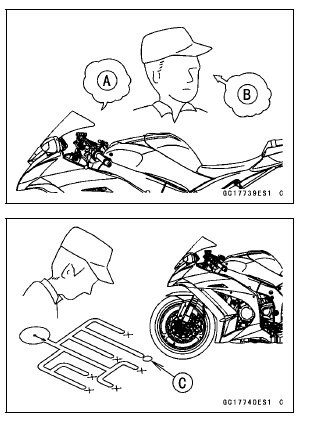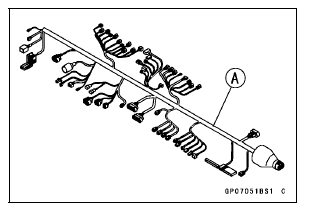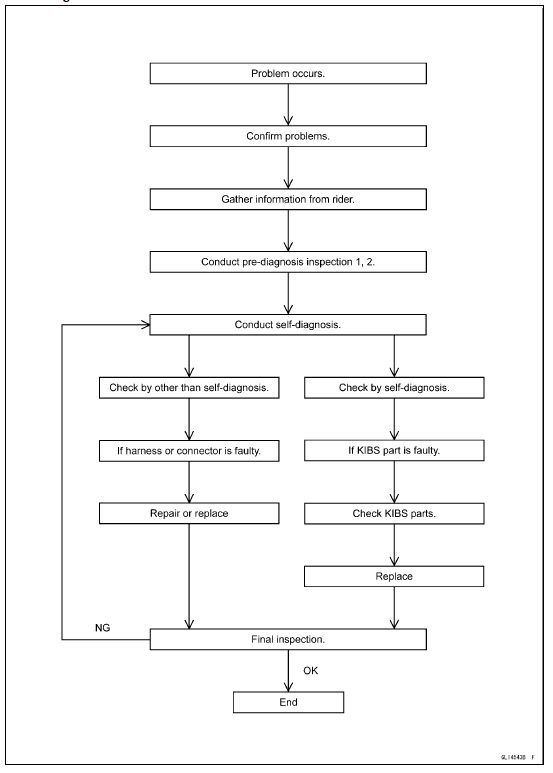

When an abnormality in the system occurs, the ABS indicator light (LED) and KIBS indicator light (LED) light up and the KIBS warning symbol are displayed on the LCD (Liquid Crystal Display) to alert the rider. In addition, the nature of the fault is stored in the memory of the KIBS hydraulic unit and FI ECU, and when in the self-diagnosis mode, the service code [A] is displayed on the LCD by the “b” and the number of two digits. When repair has been done, the both warning indicator lights (LED) and KIBS warning symbol go off and service codes are not displayed. But the service codes stored in memory of the KIBS hydraulic unit ECU and FI ECU are not erased to preserve the problem history.
When, due to a malfunction, the ABS and KIBS indicator lights (LED) remain lit, get a thorough understanding of the background before starting the repair work. Ask the rider about the conditions [B] under which the problem occurred and try to determine the cause [C]. Do not rely solely on the KIBS and DFI self-diagnosis function, use common sense; check the brakes for proper braking power, and brake fluid level, search for leaks, etc.

Even when the KIBS and DFI are operating normally, the ABS indicator light (LED) and KIBS indicator light (LED) may light up and the KIBS warning symbol are displayed on the LCD under the conditions listed below. Turn the ignition switch to OFF to go off the indicator light and the KIBS warning symbol.
Much of the KIBS troubleshooting work consists of confirming continuity of the wiring. The KIBS parts are assembled and adjusted by the manufacturer, so there is no need to disassemble or repair them. Replace the KIBS hydraulic unit.
The basic troubleshooting procedures are listed below.
Special Tool - Hand Tester: 57001-1394
If any wiring is poor, replace the damaged wiring.
If the connector is corroded or dirty, clean it carefully. If it is damaged, replace it.
Use the wiring diagram to find the ends of the lead which is suspected of being a problem.
Connect the hand tester between the ends of the leads.
Special Tool - Hand Tester: 57001-1394
Set the tester to the × 1 Ω range, and read the tester.

If the tester does not read 0 Ω, the lead is defective. Replace the main harness [A] if necessary.
If no abnormality is found in the wiring or connectors, the KIBS parts are the next likely suspects. Check each part one by one.
If an abnormality is found, replace the affected KIBS part.
KIBS Diagnosis Flow Chart

 KIBS Servicing Precautions
KIBS Servicing Precautions Inquiries to Rider
Inquiries to RiderJump starting
If your motorcycle battery is “run
down”, it should be removed and
charged. If this is not practical, a 12
volt booster battery and jumper cables
may be used to start the engine.
DANGER
Battery acid generates hydrogen
gas which is flammable and
explosive under certain conditions.
It i ...
Warning/Indicator Lights
: When the
transmission is in
neutral, the neutral indicator light goes
on.
: When the
headlight is on high
beam, the high beam indicator light
goes on.
: When the
turn signal switch is
pushed to the left or right, the turn signal
indicator light blinks. ...
KIBS Hydraulic Unit Removal
NOTICE
The KIBS hydraulic unit [A] has been adjusted
and set with precision at the factory. Therefore, it
should be handled carefully, never struck sharply,
as with a hammer, or allowed to fall on a hard
surface.
Be careful not to get water or mud on the KIBS hydraulic
unit.
Drain the b ...